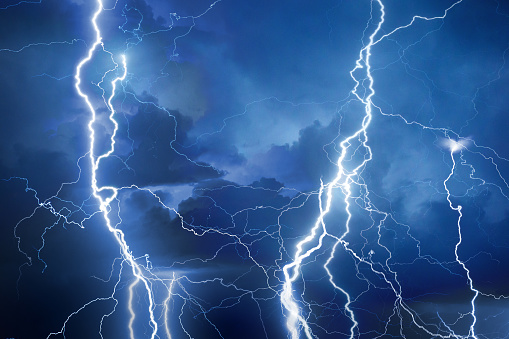Lightning & Boating don’t mix.
Lightning and Boating don’t mix. Spring and Fall bring the strongest storms of the year.
Do you have the proper PFD (personal floatation device)? How about boaters’ insurance? In the middle of a storm is NOT the time to think about these things.
Boat safety should be an ingrained part of any boating excursion, long or short.
Before you head out for a cruise, check the current weather and the predictions. Most smartphones allow you to see the weather at a moment’s notice. Be sure to check it frequently.
Suppose you are caught by surprise while on the water, head back home immediately. If the storm is between you and your home or a marina, head for another protected area onshore. You do know where they are because you studied a map before you left – Right!!
What Lightning Does to Boats and Boaters
You’re floating on a body of water in a boat. You notice the dark clouds approaching. What do you do?
First, get PFD (life preservers) on everyone.
Next, Remember, lightning strikes the tallest point on a boat (the lighting rod). As you stand in your boat – where is that lightning going to hit?
Most boats contain large amounts of metal and other conductive materials, making them an excellent target for lightning.
With a sailboat, the tallest point would be the mast. But with a bass boat, this could be the fishing chair or YOU sitting in it! No boat is immune. You don’t have to be a genius to figure out that water, wiring, and lightning do not mix well!
Smaller boats are subject to extensive damage because there are fewer places for the lightning to go. They’re also more dangerous for the passengers during an electrical storm.
Lightning can completely wipe out a boat’s electrical system and destroy the engine. It can blow holes in the hull, which causes the boat to take on water. Sinking is not out of the realm of possibilities.
Isn’t a boat Lightning-Proof?
Unlike a car, a boat does not have four rubber wheels insulating it from “ground.” Boats are potential targets whenever they are on the water.
Lightning always takes the shortest path to “ground.” On the water, “ground” is the water’s surface. The tallest object on a boat that contains metal or any conductive materials (like your body) will serve as a lightning rod.
There’s no way to predict where it will go. On larger boats, a bonding system can send the strike via a conductor to an underwater metal plate, usually constructed of copper or some other non-corrosive metal.
A bonding system uses arrestors to protect electronic equipment while providing a safe path for the lightning strike.
Caught in a Thunderstorm – what now?
If you’re in a thunderstorm out on the water, seek shelter in your boat’s cabin, if it has one. Remember, you might be the highest, conductive point that lightning sees.
If the vessel doesn’t have any shelter, remain as low as possible. Find the lowest part of the boat and try to get into the center of the boat. Don’t touch ANY metal or electronic components. Don’t be the lightning rod.
Make sure everyone on board puts on a life jacket. Here’s an excellent article to read about PFD written for kayakers, but it applies to all boating situations.
Next, decrease the speed of the boat. Don’t forget to unplug any electrical appliances or devices.
Remember, you can’t have thunder without lighting, even if you don’t see it.
Remember, boats can also be struck by lightning while docked. Leave the boat and take shelter (Not under a tree).
Will MY Boat Insurance Cover Lightning Damage?
Boat insurance should cover a boat damaged by lightning. Insurance usually covers damages done by fire, theft, lightning, wind, vandalism, and other events.
Call your licensed agent and go over your list of options and the cost of each. It’s better to be slightly “over-insured” than not to have enough coverage. A few extra dollars a month in insurance premiums could make a big difference in your coverage.
The most expensive boat insurance on the market might not necessarily be the best.
In Conclusion
In the event of a storm, get off the water, and stay as low as you can.
Tell Your Friends & Family
Have friends or neighbors you believe should see this article? Email them a link to this article – and Thank you!
You can visit Pier & Waterfront Solutions on Facebook also.
Don’t Forget – PWS is the expert when you have a waterfront problem!
Where is Pier & Waterfront Solutions?
Located at 7325 St. Hwy 57, we are about 3 miles south of Sturgeon Bay, and 1 mile past the intersection of Cty MM (heading north). Look for the intersection of Idlewild Road and Hwy 57.
ARE WE OPEN?
Pier & Waterfront Solutions has remained “open.” We have implemented measures to ensure the safety of our employees and visitors. As of Aug 1st, Wisconsin mandates the use of face masks. It’s the only known method to control the spread at this time.
While all this is going on, we are working to maintain the trusted service you expect. That’s important to us.
We are conducting as much business as possible by email, text, or phone. Site visits will continue as usual. When in-person contacts are necessary, we follow “social distancing” guidelines as closely as possible.
Call, message, or use this simple request form to get answers and quotes.
Thank you for allowing us to work with you – safely.






